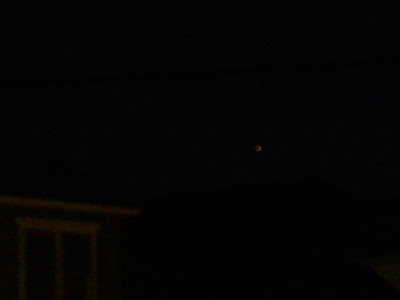
The photo above is unretouched, but has been reduced from its original size of 31.556" x 23.667" to a more manageable 10" x 7.5", so one critical detail is lost: in that photo, like in ten out of twelve of the images I took of Mercury, the planet itself appears as an extended disk.
I don't know if this is an artifact, or something real. I know I have artifacts in my images, but I have reasons to believe this is legit. Here's one of them: the picture below was one of several I took with the "digital zoom" kicked in.

And the image below is a cropped, resized portion of another image, with the foreground houses to approximately the same scale. This image was taken three minutes after the previous one, and from a different angle. (I cranked up the height on my tripod as far as it would go.)

...all of which probably proves nothing, as the digital zoom is essentially the same as a manual crop and resize. I suppose what I should have done is backed off the zoom a little and gotten an image, and then compared the relative sizes of Mercury to the relative sizes of the houses.
If I did really and truly image Mercury as an extended body, I would be truly amazed. I don't think I've ever tried photographing Jupiter. If these images are true, then Jupiter should look enormous!
I need a reality check here: Is this circular image actually the size that Mercury appears in the sky, or is it some artifact generated by my Nikon Coolpix L4 trying to process the light of Mercury?























1 comment:
We spotted Mercury tonight. Thanks
Post a Comment